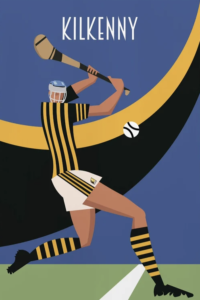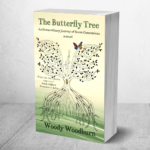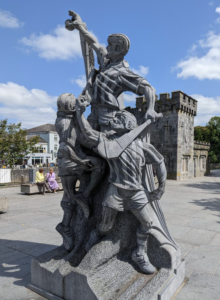Woody’s new novel “The Butterfly Tree” is available at Amazon (click here) and orderable at all bookshops.
*
“How much for this one?” I asked the proprietor of a time-portal-in-the-wall antique shop in the charming Ireland town of Kilkenny.
The hurling stick I held forth looked as ancient and weathered as the cobblestones of the narrow street outside the front door. This “hurley,” as the Irish call the bats used in the ancient Gaelic sport, had obviously been game used for many, many seasons before perhaps being forgotten in an attic for half a century.
Its age and scars only made it more attractive, not less so, much as my wife is more beautiful in my eyes now than when we first started dating in college for her laugh lines and smile crinkles illuminate her prettiness, not diminish it.
Having again fallen in love at first sight, this time with a hurley in a storefront display window, I was prepared to pay handsomely.
“Twenty’s fair, I should think,” George said, meaning British pounds which equated nearly equally in dollars.
It was so beyond fair that I felt obligated to buy something more as well to up my tab and decided on a “Guinness For Strength” tin advertising sign featuring a brawny man pulling a horse riding in a cart.
“I’m a fan,” I told George, raising my pants leg to reveal a tattoo of an Irish harp which is also the trademark symbol of the famous brewery. Throughout my Ireland trip the black body ink had been a Willy Wonka-ike Golden Ticket garnering me free Guinness pints from countless bartenders. Its magic expanded now.
“Aye, an Irishman at heart you be!” the true Irishman fairly sang and made it his gift to me.
I now felt like I was stealing from this wee elderly man with a big kind heart. Back, back, back into the bowels of the shop I ventured and returned with a second Guinness sign, this one larger and of heavy wrought iron weighing about what George charged me for it—30 pounds—and I felt our transaction was now less one-sided in my favor.
George told me a hurling stick can be a nose-breaker—“Busted it more times than I can count playing,” he said of is own beak—but my hurley quickly proved also to be a conversation icebreaker.
Still in Kilkenny, a bartender named Eoin admired my souvenir and noted, his pride emphasized at the tail end: “Had me nose broken a few times on the pitch, but never went to hospital!”
Later that day, in a taxi in Dublin, the driver pointed to his nose that zig-zagged like a slalom ski course, then traced a long, straight scar above his left brow and said: “Lucky I didn’t lose my eye. If someone has a pretty face, don’t believe ’em if they say they played the game.”
Earlier, down the block from George’s shop, a souvenir store filled with T-shirts, coffee mugs and refrigerator magnets also had a large offering of brand-new hurling sticks for it turns out the Kilkenny Cats have been a dynasty the past century, the New York Yankees of their sport.
Eying my old-but-new-to-me hurley, the clerk behind the counter asked to examine it. He flexed his fingers around the age-worn handle finding a comfortable grip, took a couple slow-motion swings, then offered to trade a new stick for it that cost 75 pounds.
I declined without hesitation and without hesitation he upped his offer to two pristine hurleys.
“No, thanks,” I again told the clerk who had the nose and face of a guy who has played his fair share of hurling.
* * *
Essay copyrights Woody Woodburn
Woody’s new novel “The Butterfly Tree” is now available in paperback and eBook at Amazon (click here), other online bookstores, and is orderable at all bookshops.
*
Woody writes a weekly column for The Ventura County Star and can be contacted at WoodyWriter@gmail.com. Follow him on Twitter and Instagram at @woodywoodburn.





